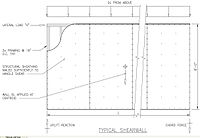
Photo from wikipedia
Simulation of brittle regime machining of materials (such as ceramics) is often difficult because of the complex material removal mechanisms involved. In this study, the discrete element method is used… Click to show full abstract
Simulation of brittle regime machining of materials (such as ceramics) is often difficult because of the complex material removal mechanisms involved. In this study, the discrete element method is used to simulate the dynamic process for machining of slip-cast fused silica ceramics. Flat-joint contact model is exploited to model contacts between particles in synthetic discrete element method models. This contact model is suitable for modeling of brittle materials with high ratios (higher than 10) of unconfined compressive strength to tensile strength. The discrete element method has the ability to simulate initiation, propagation, and coalescence of cracks leading to chip formation in the brittle regime of cutting. Applying the discrete element method, the influences of operating conditions on the creation of surface/subsurface damages, chip formation, and cutting forces are studied. It is shown that the parameters of the material model determined from conventional calibration tests do not provide quantitatively accurate prediction of cutting forces. As such, model updating is carried out using the forces obtained in the cutting experiments, and the numerical results are verified against experimental cutting forces. The differences between experimental and numerical machining forces are in the range of 10%–30%. Finally, the results of discrete element method simulations reveal that the nature of micro-crack propagation is brittle in the machining process of ceramics.
Journal Title: Proceedings of the Institution of Mechanical Engineers, Part B: Journal of Engineering Manufacture
Year Published: 2019
Link to full text (if available)
Share on Social Media: Sign Up to like & get
recommendations!